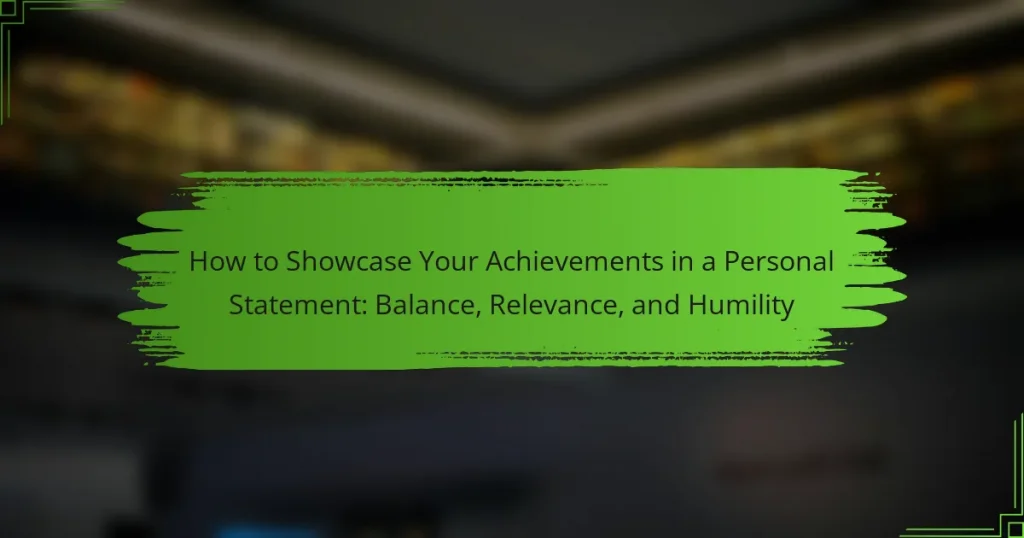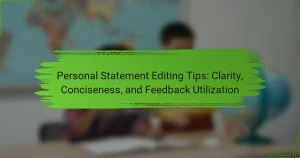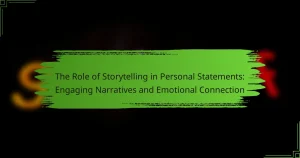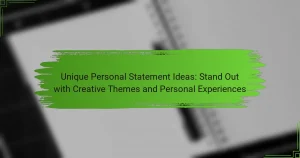
How can you effectively showcase your achievements in a personal statement?
To effectively showcase your achievements in a personal statement, focus on clarity and relevance. Start by selecting your most significant accomplishments. Choose those that directly relate to the purpose of your statement. Use specific examples to illustrate each achievement. Quantify results when possible to provide context. Highlight skills gained through these experiences. Ensure the tone remains humble, avoiding exaggeration. Integrate achievements seamlessly into your narrative. This approach maintains balance and enhances credibility.
What are the key elements to consider when highlighting achievements?
The key elements to consider when highlighting achievements are clarity, relevance, and humility. Clarity ensures that the achievements are presented in an understandable manner. Use specific examples and quantifiable results to illustrate success. Relevance means aligning achievements with the goals of the personal statement. Focus on accomplishments that relate directly to the intended audience or purpose. Humility involves presenting achievements without exaggeration. A balanced tone conveys confidence while remaining modest. These elements collectively enhance the effectiveness of showcasing achievements in a personal statement.
How do you define balance in showcasing achievements?
Balance in showcasing achievements means presenting accomplishments without overshadowing others or appearing boastful. It involves highlighting key successes while maintaining humility. Achievements should be relevant to the context, such as a personal statement. This relevance ensures that the showcased accomplishments align with the overall narrative. A balanced approach includes a mix of personal and collaborative achievements. This demonstrates both individual capability and teamwork. Research indicates that humility in self-presentation can enhance credibility (Owens & Hekman, 2012). Thus, balancing achievements fosters a well-rounded impression.
Why is relevance important when discussing achievements?
Relevance is important when discussing achievements because it ensures that the information presented aligns with the audience’s interests and the context of the discussion. When achievements are relevant, they demonstrate the individual’s suitability for a specific opportunity or role. This connection enhances the impact of the achievements being shared. For example, in a personal statement, highlighting achievements that relate to the desired program or job can significantly strengthen the application. Studies show that tailored content increases engagement and persuasiveness. Therefore, relevance not only captures attention but also reinforces the narrative of the individual’s qualifications.
What role does humility play in presenting your achievements?
Humility plays a crucial role in presenting your achievements. It allows you to convey your accomplishments without appearing arrogant. By expressing humility, you invite others to relate to your journey. This approach fosters a sense of connection with the audience. Studies show that humble individuals are often perceived as more trustworthy. According to research published in the Journal of Personality and Social Psychology, humility can enhance interpersonal relationships. When achievements are presented with humility, they are more likely to be appreciated. This balance can lead to greater impact and recognition.
How can you demonstrate humility while still showcasing accomplishments?
You can demonstrate humility while showcasing accomplishments by using inclusive language and focusing on team efforts. Acknowledge the contributions of others in your success. For example, say “I led the project with a talented team” instead of “I completed the project alone.” Share your achievements in a way that emphasizes learning and growth. Phrasing like “This experience taught me valuable lessons” reflects humility. Use metrics and outcomes to illustrate success without boasting. For instance, “Our team increased sales by 20% through collaboration” highlights achievement while maintaining modesty. This approach fosters a sense of shared success and respect for others’ roles.
What are common pitfalls to avoid regarding humility in personal statements?
Common pitfalls to avoid regarding humility in personal statements include overstating modesty, which can appear insincere. Writing too humbly may downplay significant achievements, leading to a lack of impact. Failing to balance humility with confidence can create a weak narrative. Avoid vague language that lacks specificity about accomplishments. Neglecting to provide context for achievements can make them seem less impressive. Lastly, being overly self-critical can detract from the overall message. These pitfalls can hinder the effectiveness of the personal statement.

How do you structure your personal statement for maximum impact?
To structure your personal statement for maximum impact, start with a compelling introduction. This should capture the reader’s attention and outline your main theme. Next, clearly present your achievements and experiences. Use specific examples that demonstrate your skills and growth. Each example should relate to the overall narrative of your statement. Follow this with a discussion of your future goals and how they align with your past experiences. Ensure that your conclusion reinforces your main message and leaves a lasting impression. According to research by the University of California, effective personal statements often follow this structured approach, leading to higher acceptance rates.
What is the ideal format for a personal statement?
The ideal format for a personal statement includes a clear introduction, body paragraphs, and a conclusion. The introduction should state your purpose and main theme. Each body paragraph should focus on a specific achievement or experience. Use specific examples to illustrate your points. The conclusion should summarize your main ideas and reflect on your future goals. This structure provides clarity and flow. A well-organized personal statement increases its effectiveness.
How do you organize achievements within the personal statement?
Organize achievements in a personal statement by categorizing them into relevant sections. Start with academic achievements, followed by extracurricular activities and professional experiences. Use a chronological order to present experiences clearly. Focus on the most significant achievements that align with the program or job you are applying for. Highlight the impact of each achievement with specific examples. This method ensures clarity and relevance. Research shows that structured presentations improve reader engagement and retention.
What are effective ways to introduce your achievements?
Effective ways to introduce your achievements include using a clear and concise statement. Start with a strong opening sentence that highlights the key achievement. Specify the context in which the achievement was made. Use quantifiable metrics to illustrate the impact of your achievement. Mention any relevant skills or attributes demonstrated through the achievement. Tailor the introduction to align with the audience’s interests. Incorporate storytelling elements to engage the reader. This method effectively captures attention and establishes credibility.
How can storytelling enhance your personal statement?
Storytelling can enhance your personal statement by making it more engaging and memorable. It allows you to illustrate your experiences and achievements through relatable narratives. This approach helps to humanize your application, creating an emotional connection with the reader. Research indicates that stories can improve retention of information, making your key points more impactful. For instance, a personal anecdote can highlight your problem-solving skills effectively. Furthermore, storytelling can showcase your personality, helping you stand out among other applicants. By weaving your accomplishments into a cohesive story, you provide context that emphasizes their significance. This technique can ultimately lead to a more compelling and persuasive personal statement.
What techniques can you use to weave achievements into a narrative?
Use storytelling techniques to weave achievements into a narrative. Start by establishing a clear context for the achievements. This can involve setting the scene or describing the situation that led to the accomplishments. Next, use a chronological approach to present the achievements. This method highlights the progression of skills and experiences. Incorporate specific examples to illustrate the impact of each achievement. Quantifying results can enhance credibility; for instance, stating “increased sales by 30%.” Additionally, reflect on personal growth and lessons learned from each achievement. This adds depth to the narrative. Finally, maintain a humble tone while showcasing accomplishments. This balance ensures the narrative remains relatable and engaging.
Why is it important to connect achievements to personal growth?
Connecting achievements to personal growth is essential for understanding one’s development journey. Achievements reflect the skills and knowledge acquired over time. They provide measurable evidence of progress and capabilities. Linking these accomplishments to personal growth highlights resilience and adaptability. This connection fosters self-awareness and encourages future goal setting. Research indicates that recognizing personal growth boosts motivation and self-esteem. This relationship creates a compelling narrative in personal statements, enhancing overall impact.

What strategies can help refine your personal statement?
To refine your personal statement, focus on clarity, structure, and authenticity. Start by outlining your main points clearly. This helps organize your thoughts logically. Use concise language to express your ideas effectively. Avoid jargon that may confuse the reader. Incorporate specific examples to illustrate your achievements. This adds depth and credibility to your narrative. Seek feedback from peers or mentors for an outside perspective. They can identify areas for improvement. Revise multiple drafts to enhance clarity and coherence. This iterative process ensures your statement is polished.
How can feedback improve your personal statement?
Feedback can significantly enhance your personal statement. It provides external perspectives that you may overlook. Feedback identifies areas of clarity and coherence. It helps to refine your narrative structure and flow. Constructive criticism can reveal strengths and weaknesses in your writing. Engaging with feedback encourages revisions that strengthen your argument. Research shows that peer-reviewed writing improves overall quality. A study by the University of California found that feedback can increase the effectiveness of personal statements by 30%.
Who should you ask for feedback on your personal statement?
You should ask trusted individuals for feedback on your personal statement. Ideal sources include teachers or professors familiar with your work. They can provide valuable insights on academic expectations. Additionally, peers or mentors who have experience in the application process can offer useful perspectives. Career advisors or counselors can also assist with professional tone and content. Seeking feedback from multiple sources ensures a well-rounded review. This approach helps identify strengths and areas for improvement effectively.
What specific aspects should you focus on when revising?
Focus on clarity, coherence, and conciseness when revising. Clarity ensures your message is easily understood. Coherence maintains a logical flow of ideas throughout the statement. Conciseness eliminates unnecessary words and phrases, making your achievements stand out. Additionally, check for grammatical errors and proper punctuation to enhance professionalism. Ensure that the achievements showcased align with the overall narrative of your personal statement. Each aspect contributes to a polished final product that effectively communicates your strengths.
What are some best practices for writing a compelling personal statement?
To write a compelling personal statement, focus on clarity and authenticity. Start with a strong opening that captures attention. Use specific examples to illustrate your achievements and experiences. Maintain a balance between confidence and humility throughout the statement. Tailor your content to the audience or program you are addressing. Reflect on your motivations and goals, making them clear to the reader. Edit and revise multiple times to ensure coherence and eliminate errors. Seek feedback from trusted peers or mentors to enhance your statement. These practices increase the likelihood of making a memorable impression.
How can you ensure clarity and conciseness in your writing?
To ensure clarity and conciseness in your writing, focus on using straightforward language. Avoid jargon and complex sentences. Use active voice to make sentences more direct. Limit each sentence to one main idea. Remove unnecessary words and filler phrases. Use bullet points for lists to enhance readability. Proofread to catch any ambiguous language. Employ tools like readability checkers to assess clarity. These practices help convey your message effectively, making it easier for readers to understand your achievements.
What tips can help maintain a confident yet humble tone?
To maintain a confident yet humble tone, focus on clear communication of achievements without exaggeration. Use “I” statements to express personal contributions while acknowledging the support of others. Balance self-promotion with gratitude for teamwork and mentorship. Avoid superlatives that imply superiority. Instead, highlight learning experiences and growth. Share successes as part of a collective effort. This approach fosters relatability and authenticity. Research shows that humility can enhance leadership effectiveness, as noted in the study by Owens and Hekman (2012) in the Journal of Applied Psychology.
What common mistakes should you avoid in your personal statement?
Common mistakes to avoid in your personal statement include being overly vague. Specificity helps convey your achievements clearly. Another mistake is using clichés, which can dilute your message. Personal statements should reflect your unique voice and experiences. Failing to tailor your statement to the program is also a common error. Each statement should align with the specific requirements of the institution. Additionally, neglecting to proofread can lead to grammatical errors. Such mistakes can undermine your professionalism. Lastly, being too boastful can alienate readers. A humble tone that acknowledges growth is more effective.
How can you identify and correct over-exaggeration of achievements?
To identify and correct over-exaggeration of achievements, compare claims against documented evidence. Review resumes, performance reviews, and project reports for accuracy. Seek feedback from colleagues or mentors who can provide objective assessments. Assess the language used; vague or superlative terms may indicate exaggeration. Quantify achievements with specific metrics when possible. For example, stating “increased sales by 20%” is more credible than “boosted sales significantly.” Adjust descriptions to reflect realistic contributions. This approach aligns with best practices in personal statements, promoting balance and humility.
What are the risks of failing to connect achievements to future goals?
Failing to connect achievements to future goals can lead to a lack of direction. This disconnection often results in missed opportunities for growth. Individuals may struggle to articulate their value to potential employers or educational institutions. Without a clear link, achievements may appear irrelevant. This can diminish the perceived impact of past successes. Additionally, it may hinder motivation to pursue future objectives. A study by the American Psychological Association indicates that goal-setting enhances performance. Therefore, failing to connect past achievements to future aspirations can reduce overall effectiveness.
The main entity of the article is the personal statement, specifically focusing on how to effectively showcase achievements within it. The article outlines essential strategies for presenting accomplishments with clarity, relevance, and humility. Key elements discussed include the importance of balancing confidence with modesty, structuring the statement for maximum impact, and connecting achievements to personal growth and future goals. Additionally, it highlights common pitfalls to avoid and offers techniques for integrating storytelling to enhance engagement and memorability.




